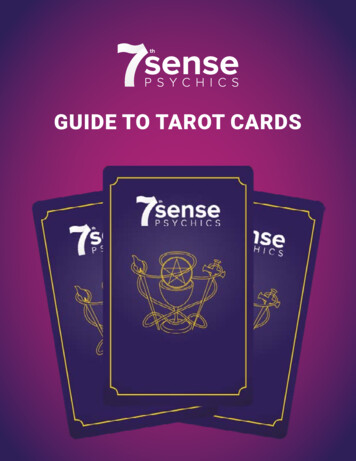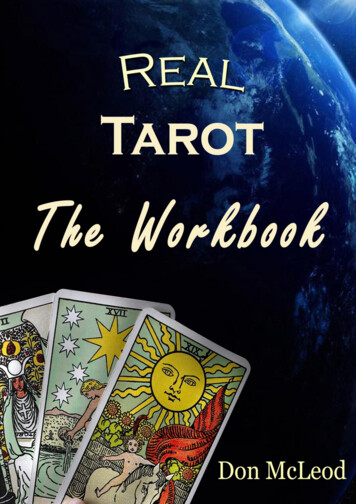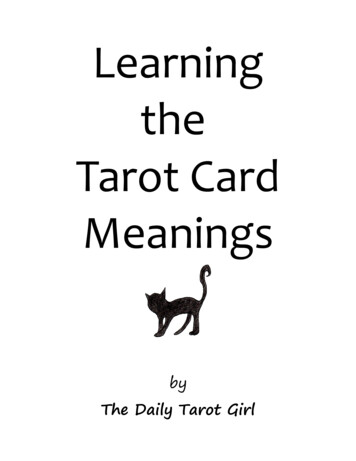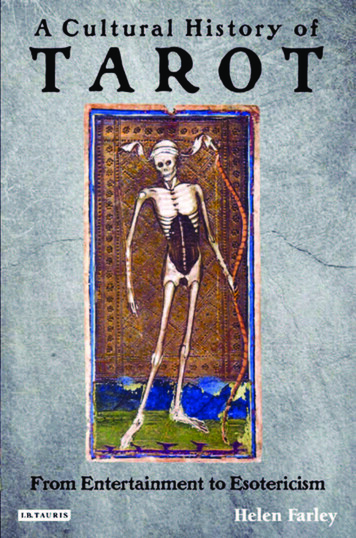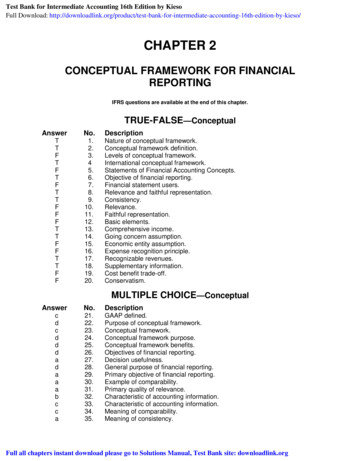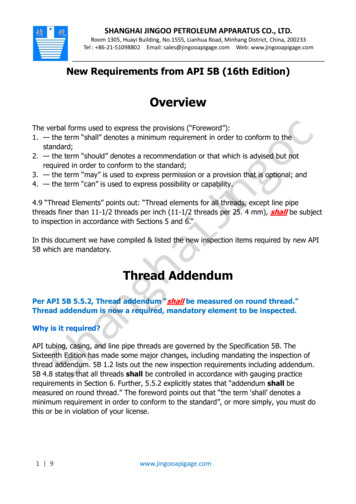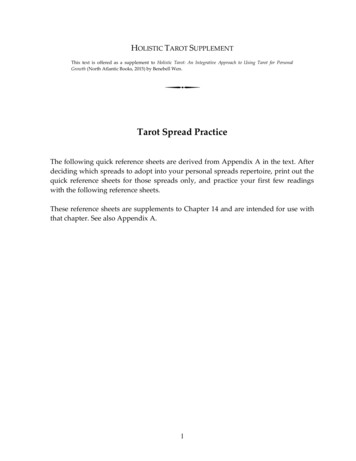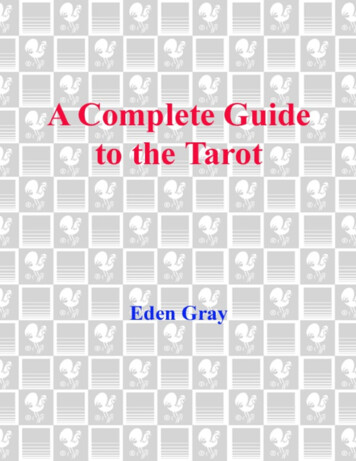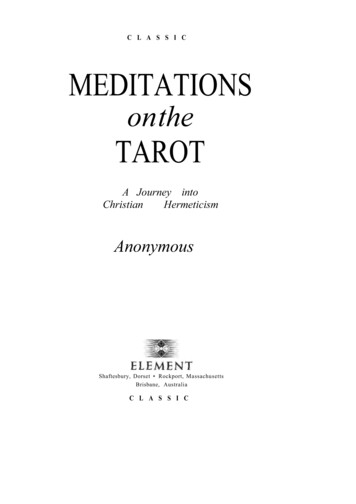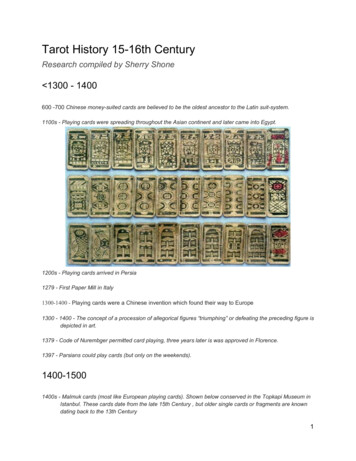
Transcription
Tarot History 15 16th CenturyResearch compiled by Sherry Shone 1300 1400600 700 Chinese money suited cards are believed to be the oldest ancestor to the Latin suit system.1100s Playing cards were spreading throughout the Asian continent and later came into Egypt.1200s Playing cards arrived in Persia1279 First Paper Mill in Italy1300 1400 Playing cards were a Chinese invention which found their way to Europe1300 1400 The concept of a procession of allegorical figures “triumphing” or defeating the preceding figure isdepicted in art.1379 Code of Nurembger permitted card playing, three years later is was approved in Florence.1397 Parsians could play cards (but only on the weekends).1400 15001400s Malmuk cards (most like European playing cards). Shown below conserved in the Topkapi Museum inIstanbul. These cards date from the late 15th Century , but older single cards or fragments are knowndating back to the 13th Century1
**note similarity between Mamluk and Tarot cards of Jean Dodal Dodal’s circa 18th century**1424. Marchesa Parisina orders two packs of inexpensive cards for her girls. This may be first evidence thatcheap printed cards were being produced.1440 Tarot “possible creation year” somewhere in northern Italy.The earliest surviving Milanese Tarot decks come from thisperiod. As noted, the Tarot deck consisted of a regular56 card deck, augmented with a hierarchy of 22 allegoricaltrump cards.1441. Francesco Sforza, future Duke of Milan, marries BiancaVisconti in Milan. Rumored to have triggered a “triumph”deck for the wedding.1442. Tarot appears in a Ferrara account book: “Ordered fromSagramoro – painted cups, coins, swords, batons, and thefigures for four packs of trionfi.”1450. Francesco Sforza writes a note requesting two decks of carteda trionfi (trumps), or if not available, carte da giocare(playing cards). He wants “the finest you can find” and needsthem by Sunday. This shows there was a standard Trionfideck that didn’t have to be described, and that was easily purchased.2
1456 & 1457. Count Borso commissioned the artist da Vicenza to create two very luxurious packs of cartegrande da trionfi with 70 cards.Colleoni Baglioni and Francesco Sforza , was produced around 1451. [5] It contains 74, i.e. 20trumps, 15 face cards, and 39 "pip" cards. The P ierpont Morgan library in New York has35, the Accademia Carrara has 26 in its catalogue, while the remaining 13 are in theprivate collection of the Colleoni family in B ergamo . The two missing trumps are the Deviland the Tower. Any reproductions only have facsimiles of the Devil and Tower.Cary Yale Named after the Cary Collection of Playing Cards, absorbed into the Yale UniversityLibrary in 1967, it is also known as the Visconti di Modrone set, and has been dated backto around 1466. Some scholars have, conversely, suggested this may be infact the oldest of sets, perhaps commissioned by Filippo Maria Visconti at theonset of the project. 67 cards (11 trumps, 17 face cards and 39 "pip" cards)have survived, which has led to the (disputed) suggestion that, given thedistribution of the Pierpont Morgan deck, the total number of cards when thisset was produced should have amounted to 86.T he Cary Yale is the onlyhistorical Western deck with six ranks of face cards, as the "Damsel" and the "Lady onhorse" supplement the traditional King, Queen, Knight and Jack. The t rumps also containsthe three theological virtues w hich appears only here and in M inchiate decks.Bonifacio Bembo This set is named after Giovanni Brambilla, who acquired the cards inVenice in 1900. [9] As of 1971, thedeck has been in the catalogue of theBrera Gallery in Milan. Apparentlycommissioned to Bonifacio Bembo byFrancesco Sforza in 1463, it now consists of 48cards with only two trumps the Emperor and theWheel of Fortune. All face cards have a giltbackground, while the pip cards have a silver one.The seven remaining face cards are: Knight and Jack ofcups; Knight and Jack of denari; Knight, Jack andQueen of bastoni. Almost all "pip" cards havesurvived, as this set is only missing the four ofdenari.1500 1600s1492 “Charles VI” Tarot cards. Three decks were bought for King Charles VI of France. Commissioned fromartist Jacques Gringonneur. Consisted of 17 cards, painted on vellum, with golden edges. Red/Blue3
pigments were used by mummy’s dust1 (or blood) and lapis lazuli.2 . They currently are in theBibliotheque Nationale, Paris.Early 1500s Minchiate deck invented in Florence. An expanded tarot deck with additional trumps depictingthe four elements and twelve zodiac signs. The Knights become Centaurs.By the 1500s, the Italian aristocracy was enjoying a game known as “tarocchi appropriati,” in which playerswere dealt random cards and used thematic associations with these cards to write poetic verses aboutone another. These predictive cards were referred to as “sortes,” meaning destinies or lots. Tarocchi isthe italian word for the French word TarotOh my! 1534. The Speaking Cards by Pietro Aretino published in Venice. Part of an erotic literary text thatgives information on the names and order of the trumps during the course of a dialog. Aretino alsowrote (T alanta ) describes, in scene XIII, allegorical tool for the Chariot we know of today interestingnote this occurs in scene 13 .31575 Venice first printed account of a game of tarot.1500s Tarot de Marseille contains fifty six cards in the four standard S uits . In French language versions ofthe Tarot de Marseille, those suits are identified by their F rench names of Bâtons (Rods, Staves,Sceptres, or Wands), Épées (Swords), Coupes (Cups), and Deniers (Coins). These count from Ace to10.Significance of the shape of the swords. Opposite of Italian pips in the playing card games the Marseille s uitof swords are drawn as abstract symbols in curved lines, forming a shape reminiscent of a mandorla .This figure (oval figures) is an architectural feature that distinguishes holy influence.On the even numbered cards, the abstract curved lines are all that is present. On theodd numbered cards, a single fully rendered sword is rendered inside the abstractdesigns.The suit of wands is drawn as straight objects that cross to form a lattice in the highernumbers; on odd numbered wands cards, a single vertical wand runs through themiddle of the lattice.1The pigment, a favored shade of the Pre Raphaelites, was first made with Egyptian mummies, both cat and human, that were ground up and mixed with white pitch and myrrh. It had a great fleshy color, but due to the actual fleshy components it would crackover time. Martin Drölling, who painted the work shown above, reportedly used the mummies of French kings dug up fromSaint Denis in Paris.2Lapis Lazuli pigment was made from grinding up Lapis Lazuli semi precious stones. Its use goes back to the 6th century in Afghanistan, but its popularity really took off with wealthy Renaissance patrons who wanted the stunning blue on the robes of Maryand Jesus in religious paintings. The “ultra marine” color, as it was also known, largely disappeared as it was so incrediblyexpensive and required quarries to collect the stones.3In scene XIII, where Aretino describes the encounter of Talanta with the parasite Branca and the Captain Tinca, among the attributes which the latter, hopelessly in love with Talanta, addresses to her, along with "helmet of my head, armor of my back,legging of my shins, harness of my steed, pendant of my medals", we also find "chariot of my triumph”, because he consideredTalanta the object who motivated or rather 'conducted' him to search for situations to conquer. Although this speech is not in thecontext of the game then called “Triumphs”, but the same Renaissance game, called “ludus tarochorum” in the period in whichAretino composed this comedy, it appears of some importance when one considers that the meaning of that card would be carrustriumphalis , i.e. the pursuit of personal triumph and victory, of which the chariot becomes an allegorical tool meaning not only“movement toward”, but also a "motivational push" .4
On the tens of both swords and batons, two fully rendered objects appear imposed on the abstract designs.The straight lined wands and the curved swords continue the tradition of Mamluk playing cards, in whichthe swords represented scimitars and the wands p olo mallets .The Valet de Bâtons (French "Page of Batons") is another card worth noting in this regard. In the Tarot deMarseille, the title of that card generally appears on the side of the card.The Death XIII card is generally left unnamed in the various old and modern versions of the Tarot de Marseille,but it is worth noting that in the Noblet Tarot de Marseille (circa 1650), the card was named LAMORT(Death). In at least some printings of the French/English bilingual version of the Grimaud Tarot deMarseille, the XIII card is named "La Mort" in French and named "Death" in English. In many moderntarot decks (e.g., Rider Waite Smith), the XIII card is named Death. In at least one 19th century Italiantarot deck (e.g., the one photo reproduced by Italian publisher Lo Scarabeo as the "Ancient ItalianTarots" deck), the card is named "IL TREDICI" ( Italian "Thirteen").1589 Venice. Records of the Inquisition show the Devil card being used as a focus of veneration and prayer.It’s notable that Tarot itself is not considered evil by association.Resources:WrittenWebsitesThe Tarot Bible Kathleen McCormackhttp://www.tarotpedia.com/wiki/Tarot Historyhttp://tarot heritage.com/history 4/tarot history //tarot heritage.com/history 4/tarot history ch/library catalogs databases/guide cary collection playing cardshttp://www.strangehistory.net/2012/06/23/the eastern origins of playing cards/http://brbl w.letarot.it/page.aspx?id 238&lng engVideosPaul Gipp, Tarot for Normal People :https://www.youtube.com/watch?v zoUXNX8GOjoTarot College Course:https://www.youtube.com/watch?v uNU4wdMSEj05
Tarot History 15 16th Century . As noted, the Tarot deck consisted of a regular 56 card deck, augmented with a hierarchy of 22 allegorical . Oh my! 1534. The Speaking Cards by Pietro Aretino published in Venice. Part of an erotic literary text that gives information on the names and order of the trumps during the course of a dialog. Aretino also .
